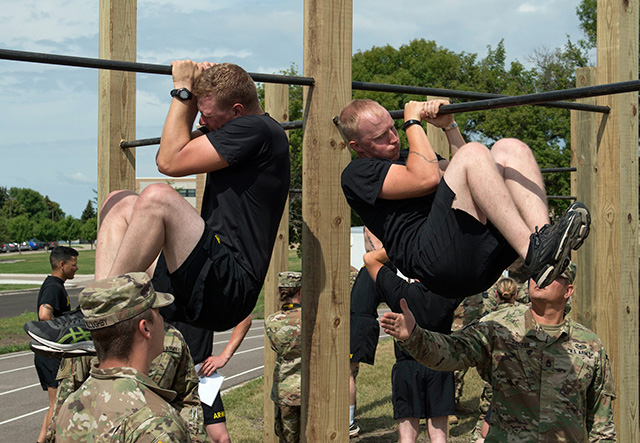The leg tuck test is a test of muscle strength. In this test, the participant hangs from an overhead bar, and flexes to bring up the knees to touch both elbows. See also the similar Leg Raises Test and the P90X Ins & Outs Core Strength Test.
test purpose: to measure core stability, hip flexor strength and upper body muscle endurance
equipment required: a horizontal bar, high enough off the ground so that the feet do not touch the ground when a person is hanging from the bar.
pre-test: Explain the test procedures to the subject. Perform screening of health risks and obtain informed consent. Prepare forms and record basic information such as age, height, body weight, gender and test conditions. Measure and record height of the bar. Perform a standard warm-up. See more details of pre-test procedures.
 leg tuck exercise
leg tuck exerciseprocedure: the subject grasps a high horizontal bar with alternating grip, arms straight and the feet hanging down. This is called the 'dead hang' position. When ready, the subject flexes with the elbows, hips and knees to touch both elbows to the knees or thighs. The legs are dropped with control and the body is back in the dead hang position. One cycle from the dead hang position to the up position and back again counts as one complete repetition. Repeat this action as many times as possible. It is not a timed test, the subject decides when to stop the test, and the total complete leg tucks is recorded. If the knees do not touch or the arms are not fully extended in the down position, the repetition does not count.
scoring: The total number of repetitions is recorded.
advantages: the equipment needed for this test is readily available, and the test is easy and quick to perform.
disadvantages: the body weight of the subject has a great effect on the results of this test.
The Test in Action
- This test is part of the new Army Combat Fitness Test.
Similar Tests
- See also the Leg Raises Test
- The P90X Ins & Outs Core Strength Test.
Related Pages
- Overhand or underhand - a description of each of the grip types
- Other strength tests


 Current Events
Current Events